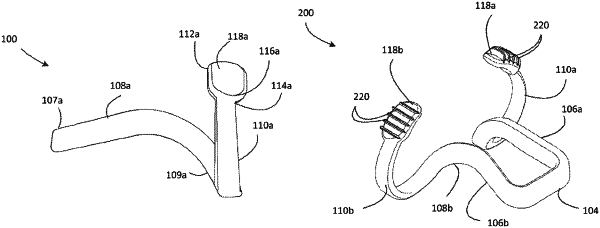| CPC A61F 5/08 (2013.01) [A61M 15/085 (2014.02); A61M 21/02 (2013.01); A61M 29/00 (2013.01); A61M 31/00 (2013.01); A61M 2021/0016 (2013.01); A61M 2205/75 (2013.01); A61M 2210/0618 (2013.01)] | 25 Claims |

|
1. A nasal dilator device comprising:
a substantially U-shaped body including:
a central portion adapted to span a septum of a nose when worn by a user, and
a first leg member and a second leg member extending from the central portion in a first plane;
a first cantilever rib member extending outward from the U-shaped body in a second plane;
a second cantilever rib member extending outward from the U-shaped body in a third plane;
wherein the first cantilever rib member and the second cantilever rib member extend away from each other;
a first intermediate section connecting an end of the first leg member to a proximal end of the first cantilever rib member, wherein a proximal end of the first intermediate section is connected to the end of the first leg member and a distal end of the first intermediate section is connected to the proximal end of the first cantilever rib member, wherein the first intermediate section extends between the first plane and the second plane such that, when said nasal device is in use and is worn by a user, the first intermediate section extends from the first leg member substantially downwards towards a floor of a respective nasal passage to the first cantilever rib member;
a second intermediate section connecting an end of the second leg member to a proximal end of the second cantilever rib member, wherein a proximal end of the second intermediate section is connected to the end of the second leg member and a distal end of the second intermediate section is connected to the proximal end of the second cantilever rib member, wherein the second intermediate section extends between the first plane and the third plane such that, when said nasal device is in use and is worn by a user, the second intermediate section extends from the second leg member substantially downwards towards a floor of the respective nasal passage to the second cantilever rib member;
a first and second releasable attachment mechanism for releasably attaching the first and second cantilever rib members, respectively, to the U-shaped body; and
wherein the first leg member and the second leg member are inclined towards each other such that a greater distance is provided between the first leg member and the second leg member at ends of the first and second leg members closest the central portion relative to a distance provided between the first leg member and the second leg member at the ends of the first and second leg members connected to the first and second intermediate sections respectively, and
wherein the first intermediate section and the second intermediate section are adapted, in use, to extend along a portion of the septum to the first cantilever rib member and the second cantilever rib member respectively, and
wherein the first cantilever rib member and the second cantilever rib member are elongated and arcuate rib members, each having a curvature along its length, wherein the first cantilever rib member and the second cantilever rib member extend arcuately from the first intermediate section and the second intermediate section respectively in a substantially upward direction from the floor of the respective nasal passage to an inner wall of a respective nostril along their length in the second and third planes respectively when the nasal device is worn by a user.
|